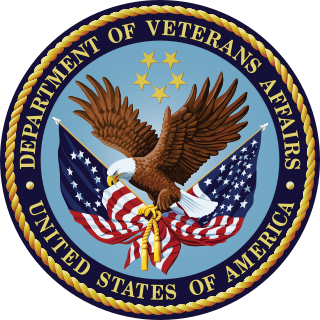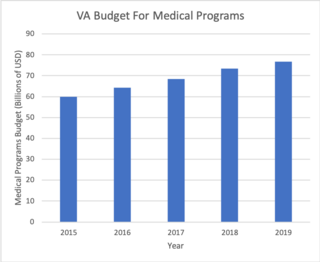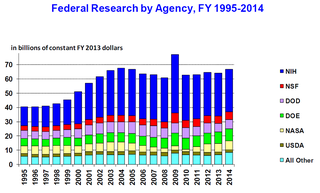Related Research Articles

The United States Department of Veterans Affairs (VA) is a Cabinet-level executive branch department of the federal government charged with providing lifelong healthcare services to eligible military veterans at the 170 VA medical centers and outpatient clinics located throughout the country. Non-healthcare benefits include disability compensation, vocational rehabilitation, education assistance, home loans, and life insurance. The VA also provides burial and memorial benefits to eligible veterans and family members at 135 national cemeteries.

The Veterans Health Administration (VHA) is the component of the United States Department of Veterans Affairs (VA) led by the Under Secretary of Veterans Affairs for Health that implements the healthcare program of the VA through a nationalized healthcare service in the United States, providing healthcare and healthcare-adjacent services to Veterans through the administration and operation of 146 VA Medical Centers (VAMC) with integrated outpatient clinics, 772 Community Based Outpatient Clinics (CBOC), and 134 VA Community Living Centers Programs. It is the largest division in the Department, and second largest in the entire federal government, employing over 350,000 employees. All VA hospitals, clinics and medical centers are owned by and operated by the Department of Veterans Affairs as opposed to private companies, and all of the staff employed in VA hospitals are government employees. Because of this, Veterans that qualify for VHA healthcare do not pay premiums or deductibles for their healthcare but may have to make copayments depending on what procedure they are having. VHA is distinct from the U.S. Department of Defense Military Health System of which it is not a part.
The excepted service is the part of the United States federal civil service that is not part of either the competitive service or the Senior Executive Service. It provides streamlined hiring processes to be used under certain circumstances.

The Agency for Healthcare Research and Quality is one of twelve agencies within the United States Department of Health and Human Services (HHS). The agency is headquartered in North Bethesda, Maryland, a suburb of Washington, D.C.. It was established as the Agency for Health Care Policy and Research (AHCPR) in 1989 as a constituent unit of the Public Health Service (PHS) to enhance the quality, appropriateness, and effectiveness of health care services and access to care by conducting and supporting research, demonstration projects, and evaluations; developing guidelines; and disseminating information on health care services and delivery systems.
The Small Business Innovation Research program is a U.S. government funding program, coordinated by the Small Business Administration, intended to help certain small businesses conduct research and development (R&D). Funding takes the form of contracts or grants. The recipient projects must have the potential for commercialization and must meet specific U.S. government R&D needs.
Executive Schedule is the system of salaries given to the highest-ranked appointed officials in the executive branch of the U.S. government. The president of the United States appoints individuals to these positions, most with the advice and consent of the United States Senate. They include members of the president's Cabinet, several top-ranking officials of each executive department, the directors of some of the more prominent departmental and independent agencies, and several members of the Executive Office of the President.

The Administration for Strategic Preparedness and Response (ASPR) is an operating agency of the U.S. Public Health Service within the Department of Health and Human Services that focuses preventing, preparing for, and responding to the adverse health effects of public health emergencies and disasters. Its functions include preparedness planning and response; building federal emergency medical operational capabilities; countermeasures research, advance development, and procurement; and grants to strengthen the capabilities of hospitals and health care systems in public health emergencies and medical disasters. The office provides federal support, including medical professionals through ASPR’s National Disaster Medical System, to augment state and local capabilities during an emergency or disaster.

The science policy of the United States is the responsibility of many organizations throughout the federal government. Much of the large-scale policy is made through the legislative budget process of enacting the yearly federal budget, although there are other legislative issues that directly involve science, such as energy policy, climate change, and stem cell research. Further decisions are made by the various federal agencies which spend the funds allocated by Congress, either on in-house research or by granting funds to outside organizations and researchers.
STAR METRICS was a partnership between United States federal science agencies and research institutions to document the return on investment, research impact, and social outcomes of federally funded research and development. The federal consortium comprised the White House Office of Science and Technology Policy (OSTP), the National Institutes of Health (NIH), the National Science Foundation, (NSF), the US Department of Agriculture, (USDA), and the US Environmental Protection Agency,(EPA). NIH was the host agency for the consortium, which was governed by an Executive Committee and an advisory interagency working group.

The Pandemic and All-Hazards Preparedness Reauthorization Act of 2013 is a law enacted by the 113th United States Congress. The Act amends the Public Health Service Act in order to extend, fund, and improve several programs designed to prepare the United States and health professionals in the event of a pandemic, epidemic, or biological, chemical, radiological, or nuclear accident or attack. The Act clarifies the authority of different American officials, makes it easier to temporarily reassign personnel to respond to emergency situations, and alters the process for testing and producing medical countermeasures. The Act is focused on improving preparedness for any public health emergency.
Joel Kupersmith, M.D., an American physician, is the former dean of the Texas Tech University School of Medicine, and head of the Office of Research and Development of the Department of Veterans Affairs. He is the former Director, Veterans Initiatives and Professor of Medicine at Georgetown University.
The Office of the Assistant Secretary for Planning and Evaluation (ASPE) is the principal advisory group to the United States Secretary of the Department of Health and Human Services (HHS) on policy development and provides coordination and support for HHS's strategic and policy planning, planning and development of legislation, program evaluation, data gathering, policy-related research, and regulatory program.

The Military Construction and Veterans Affairs and Related Agencies Appropriations Act, 2015 is a bill that would make appropriations for fiscal year 2015 for military construction and the United States Department of Veterans Affairs. The bill is considered one of the two easiest appropriations bills to pass each year. The total amount appropriated by the introduced version of the bill is $71.5 billion, approximately $1.8 billion less than fiscal year 2014 due to a decrease in the need for military construction.

United States military veteran suicide is an ongoing phenomenon regarding the high rate of suicide among U.S. military veterans in comparison to the general civilian public. A focus on preventing veteran suicide began in 1958 with the opening of the first suicide prevention center in the United States. During the mid-1990s, a paradigm shift in addressing veteran suicide occurred with the development of a national strategy which included several Congressional Resolutions. More advancements were made in 2007, when the Joshua Omvig Veterans Suicide Prevention Act created a comprehensive program including outreach at each Veterans Affairs Office (VA) and the implementation of a 24-hour crisis hotline. PTSD, depression, and combat-related guilt in veterans are often related to suicide as it can be difficult for veterans to transition to civilian life.

The Veterans' Access to Care through Choice, Accountability, and Transparency Act of 2014, also known as the Veterans Choice Act, is a United States public law that is intended to address the ongoing Veterans Health Administration scandal of 2014. The law expanded the number of options veterans have for receiving care and granted the United States Secretary of Veterans Affairs more power to fire senior executives. The Veterans Health Administration scandal of 2014 began with the discovery that there was on-going systematic lying by the Veterans Health Administration about the wait times veterans experienced waiting to be seen by doctors. By June 5, 2014, Veterans Affairs internal investigations had identified a total of 35 veterans who had died while waiting for care in the Phoenix VHA system. Another audit determined that "more than 57,000 veterans waited at least 90 days to see a doctor, while another 63,000 over the last decade never received an initial appointment."

Rory A. Cooper is an American bioengineer who currently serves as FISA/PVA Distinguished Professor, Past Chair, in the Department of Rehabilitation Science and Technology and professor of bioengineering, physical medicine and rehabilitation, and orthopedic surgery at the University of Pittsburgh. He is also assistant vice chancellor for research for STEM and Health Sciences Collaboration. He holds an adjunct faculty position at the Robotics Institute of Carnegie Mellon University, and is an invited professor at Xi'an Jiaotong University in Xi'an, China.

The Minneapolis Veterans Affairs Health Care System (VAHCS) is network of hospital and outpatient clinics based in Minneapolis, Minnesota, USA. It belongs to the VISN23 VA Midwest Health Care Network managed by the Veterans Health Administration of the Department of Veterans Affairs. The Minneapolis VAHCS provides healthcare for United States military veterans in areas such as medicine, surgery, psychiatry, physical medicine and rehabilitation, neurology, oncology, dentistry, geriatrics and extended care. As a teaching hospital, it operates comprehensive training programs for multiple treatment specialties. The Minneapolis VAHCS also hosts one of the largest research programs of any VA health care system and maintains research affiliations with the University of Minnesota.
References
- ↑ "Science, Technology, STEM Education, and 21st Century Infrastructure in the 2012 Budget" (PDF). United States Office of Science and Technology Policy. pp. 14 February 2011. Retrieved 25 November 2011.
- 1 2 "VA Research and Development Program Overview:" (PDF). United States Veterans Health Administration Office of Research and Development. Retrieved 25 November 2011.
- ↑ "Historical Accomplishments". United States Veterans Health Administration Office of Research and Development. 4 October 2011. Retrieved 25 November 2011.
- ↑ "Research Programs". United States Veterans Health Administration Office of Research and Development. 17 October 2011. Retrieved 25 November 2011.